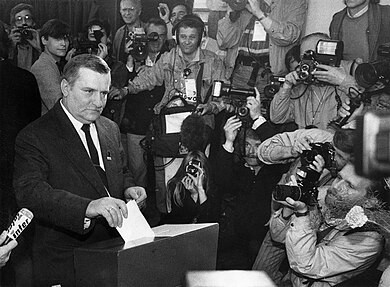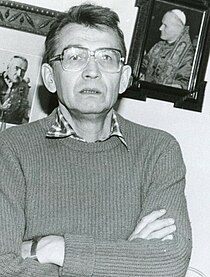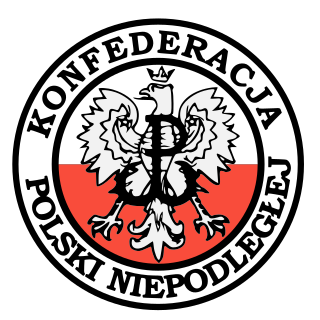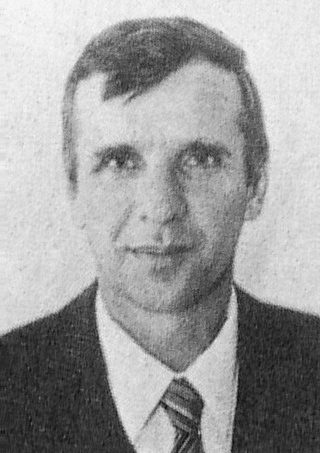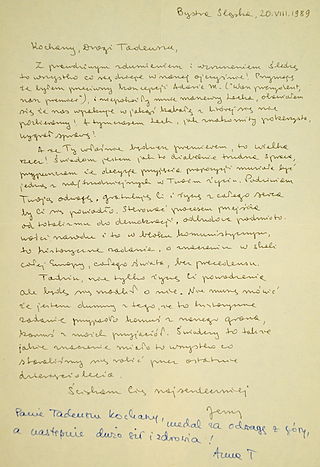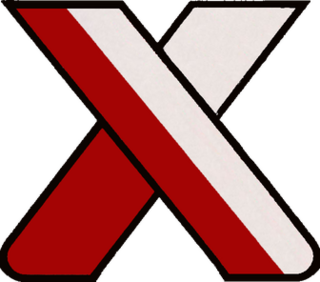First round
While most voters generally believed the candidates they backed would do best to solve most of the country's issues, there were two major outliers - ~40% of voters believed Bartoszcze would best fix the country's agricultural problems, compared to his 7.15% general vote share, and ~20% of voters believed Moczulski would best deal with the communist nomenklatura and withdrawal from the Eastern bloc, compared to his 2.50% vote share. [11]
Mazowiecki's starting situation was rather unfavorable. Despite holding control over TVP, the Polish national television, his team were inept at utilizing such a vital campaign organ (which would provide tremendous help to every consecutive presidential candidate which controlled it). Though well-respected, the public perceived Mazowiecki as uncharismatic, [12] [13] and his lack of oratory skills led to him massively limiting his public appearances. In light of these obstacles, Mazowiecki tried to deemphasize the importance of his own persona, instead elevating his electoral platform, a strategy that found little appeal outside of intelligentsia circles (which already overwhelmingly supported him). A defining symbol of Mazowiecki's personal isolation was an advertisement his team aired at the beginning of the campaign, presenting him walking around a park, surrounded by bodyguards. In contrast, Wałesa's image was quite overt - Solidarity's chairman held dozens of rallies, meetings and other public events, his persona was charming, characterized as a "plebeian tribune", a "sheriff" bringing communists to justice, promising to directly overlook everything that needed resolution - such a persona enjoyed much public popularity. [2] Tymiński's campaign, that completely faltered at the start, blossomed after TVP began the period of airing campaign ads. His advertisements, which in a simple fasion criticized the government and proposed a "real alternative". The advertisements were so effective that even in an entire voivodeship where Tymiński's campaign had no presence, he had received the largest number of votes of any candidate in the first round. However, that did not mean Tymiński did not campaign in other ways - he held several rallies where he tried to expand his appeal to certain groups. [2]
The Prime Minister's presidential campaign oriented around defending and lauding his accomplishments - notably beginning the economic transformation, signing a treaty with Germany that put an end to fears of Germany pursuing reclamation of its pre-war borders - and convincing undecideds to see the reforms positively. However, his campaign had very little in terms of actual election promises. Meanwhile, Wałesa promised to soften the mass privatization schemes of Finance Minister Leszek Balcerowicz which was largely responsible for perpetually increasing poverty and unemployment and give every Pole a "hundred million (old) złotys" to let citizens better participate in the economic restructuring. Despite his campaign team writing a formal electoral program titled "New beginning", Wałęsa did not stick to it, and later admitted he did not even read it. [2] Wałesa did not, however, promise to solve every problem, unlike Tymiński, whose extreme promises became a major point of success among the increasing crowds of citizens dissatisfied with the new rule of Solidarity. [2]
At later points of the campaign, Mazowiecki's campaign turned rather negative, disorienting his own voterbase and hurting his image, and began airing advertisements showing Wałesa amputating Poland from western Europe with an axe, or with said axe destroying an alarm clock which had previously been repaired by presumably Mazowiecki. [2] Wałęsa's response to such advertisements was to air his own, notably a cartoon in which, wielding the same axe, he destroyed the "thick stroke" [lower-alpha 2] and chased away red spiders, signifying communists. Mazowiecki's ally, Gazeta Wyborcza editor-in-chief Adam Michnik, presented Wałesa as a dangerous strongman who would introduce a "catastrophic, Peronist-esque regime". [6] In some circles, Mazowiecki was accused of secretly having Jewish ancestry, a notion which he rejected and condemned. [14] Meanwhile, Wałęsa insinuated Mazowiecki led an inactive, elite government that prided itself in the prestige of governance alone, contrasting it with proposed his model of real societal intervention. [2]
Mazowiecki, with his fatally operated campaign, quickly declined in opinion polls. Despite them showing Mazowiecki continuously declining, Mazowiecki's team was in denial that they had fallen behind Wałęsa (who by November polled 10 points ahead of the Prime Minister). His fall was so severe that he had fallen even behind Tymiński - who was considered such a nonfactor that Mazowiecki's team only took him into account after Tymiński accused him of treason during a rally a mere week before election day. [2]
On 25 November, the first round of voting took place. In an upset victory, Mazowiecki failed to enter the second round, falling five percentage points behind Tymiński. The results were as follows: Wałęsa - 39.96%, Tymiński - 23.10%, Mazowiecki - 18.08%, Cimoszewicz - 9.21%, Bartoszcze - 7.15%, Moczulski - 2.50%. The day after the election, Mazowiecki, humiliated, announced that he would soon be resigning from the office of Prime Minister, which he did on 12 January next year.
Second round
After the announcement of the results, Wałęsa received a large array of endorsements from the majority of his former opponents - on 28 November, OKP formally endorsed Wałęsa's candidacy. On November 30, the Catholic Church in Poland, which did not directly endorse any candidate beforehand, finally chose to endorse Wałęsa. On 1 and 2 December, ROAD and then Mazowiecki begrudgingly endorsed him as well. PSL and KPN also endorsed him - only Cimoszewicz, who represented the postcommunist camp, did not support either candidate. [2]
Tymiński attempted to extend his appeal towards Mazowiecki's and Cimoszewicz's liberal and leftist voters. His attempts at broadening his voterbase, like opposing anti-abortion laws, or praising President Jaruzelski and the period of martial law, contradicted his previous statements about his deep belief in Catholic social teaching, and targeted the intelligentsia environment which were not receptive to his overall populist image in general. Tymiński's momentum, which rose extremely quickly, also seemed to reach its peak at the beginning of the second round. [2]
On 1 December, a pseudo-debate, which took form of a joint press conference where the candidates were free to talk with each other, took place. Tymiński appeared with a black briefcase, claiming it contained incriminating evidence against Wałesa, who replied by ordering Tymiński to show the evidence, assuming Tymiński was bluffing. Tymiński, who did not open the briefcase, proved the clear loser of the debate. A legitimate debate planned for the next day was cancelled when Tymiński refused to take part, his image being damaged enough in the previous debate. [2]
TVP released material in a smear campaign against Tymiński on 4 December, pinning several allegations against him, among which, that he abused his wife and children. Several years after the campaign, Tymiński won a lawsuit against TVP for defamation, but at that point the election had already been long over. [2]
On 9 December, the second round of the presidential election took place, in which Wałesa won in a landslide victory of 74.25%, compared to Tymiński's 25.75%, which was the largest landslide in the history of Polish elections.









